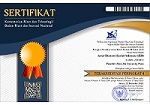Does Service Innovation, Reputation Risk, and Word of Mouth Impact Customer Behavior in Choosing Islamic Banking? An Empirical Evidence in Indonesia
Abstract
Keywords
Full Text:
PDFReferences
Alnaser, W. E., & Alnaser, N. W. (2011). The status of renewable energy in the GCC countries. Renewable and Sustainable Energy Reviews, 15(6), 3074–3098. https://doi.org/10.1016/j.rser.2011.03.021
Anderson, E. W. (1998). Customer satisfaction and word of mouth. Journal of Service Research, 1(1), 5–17. https://doi.org/10.1177/109467059800100102
Baidhowi, B. (2018). Sharia Banking Opportunities and Challenges in the Digital Era. 192(Icils), 157–161. https://doi.org/10.2991/icils-18.2018.30
Banerjee, A., & Fudenberg, D. (2004). Word-of-mouth learning. 46, 1–22. https://doi.org/10.1016/S0899-8256(03)00048-4
Bebbington, J., Larrinaga, C., & Moneva, J. M. (2008). Corporate social reporting and reputation risk management. Accounting, Auditing & Accountability Journal, 21(3), 337–361. https://doi.org/10.1108/09513570810863932
Berger, J. (2014). Word of mouth and interpersonal communication: A review and directions for future research. Journal of Consumer Psychology, 24(4), 586–607. https://doi.org/10.1016/j.jcps.2014.05.002
Berry, L. L., Shankar, V., Parish, J. T., Cadwallader, S., & Dotzel, T. (2006). Creating new markets through service innovation. MIT Sloan Management Review, 47(2), 56–63.
Bodibe, S., Chiliya, N., & Chikandiwa, C. T. (2016). The factors affecting customers’ decisions to adopt Islamic banking. Banks and Bank Systems, 11(4), 144–151. https://doi.org/10.21511/bbs.11(4-1).2016.05
Buttle, F. A. (1998). Word of mouth: Understanding and managing referral marketing. Journal of Strategic Marketing, 6(3), 241–254. https://doi.org/10.1080/096525498346658
Chaidir Iswanaji, Aziz muslim, M. Z. N. H. (2022). IJARAH COLLABORATIVE SERVICE MODEL IN SHARIA BANKING. Indonesian Interdisciplinary Journal of Sharia Economics (IIJSE), 5(2), 702–718.
Choiriyah, C., Saprida, S., & Sari, E. (2021). Development of Sharia Banking System In Indonesia. Mizan: Journal of Islamic Law, 5(1), 17. https://doi.org/10.32507/mizan.v5i1.923
Dörner, N., Gassmann, O., & Gebauer, H. (2011). Service innovation: Why is it so difficult to accomplish? Journal of Business Strategy, 32(3), 37–46. https://doi.org/10.1108/02756661111121983
Durst, S., Mention, A. L., & Poutanen, P. (2015). Service innovation and its impact: What do we know about? Investigaciones Europeas de Direccion y Economia de La Empresa, 21(2), 65–72. https://doi.org/10.1016/j.iedee.2014.07.003
Eckert, C. (2017). Corporate reputation and reputation risk: Definition and measurement from a (risk) management perspective. Journal of Risk Finance, 18(2), 145–158. https://doi.org/10.1108/JRF-06-2016-0075
Godes, D., & Mayzlin, D. (2004). Using online conversations to study word-of-mouth communication. Marketing Science, 23(4). https://doi.org/10.1287/mksc.1040.0071
Juhandi, N., Rahardjo, B., Tantriningsih, H. A., & Fahlevi, M. (2019). The GROWTH OF SHARIA BANKING IN ASIA. Journal of Research in Business, Economics and Management, 12(2), 2341–2347. http://www.scitecresearch.com/journals/index.php/jrbem/article/view/1708
Karwowski, M., & Raulinajtys-Grzybek, M. (2021). The application of corporate social responsibility (CSR) actions for mitigation of environmental, social, corporate governance (ESG) and reputational risk in integrated reports. Corporate Social Responsibility and Environmental Management, 28(4), 1270–1284. https://doi.org/10.1002/csr.2137
Lubis, A., Dalimunthe, R., Absah, Y., & Fawzeea, B. K. (2020). The Influence of Customer Relationship Management (CRM) Indicators on Customer Loyalty of Sharia Based Banking System. GATR Journal of Management and Marketing Review, 5(1), 84–92. https://doi.org/10.35609/jmmr.2020.5.1(8)
Miles, I. (2009). Innovation in Services. The Oxford Handbook of Innovation, 9. https://doi.org/10.1093/oxfordhb/9780199286805.003.0016
Mulia, D., Usman, H., & Parwanto, N. B. (2020). The role of customer intimacy in increasing Islamic bank customer loyalty in using e-banking and m-banking. Journal of Islamic Marketing, 12(6), 1097–1123. https://doi.org/10.1108/JIMA-09-2019-0190
Noviarita, H., Velina, Y., Ekawati, E., Hanif, & Susanto, I. (2021). Customer Loyalty in Sharia Bank Savings Products. Utopía y Praxis Latinoamericana, 26, 109–116.
Nugroho, A. P., Hidayat, A., & Kusuma, H. (2017). The influence of religiosity and self-efficacy on the saving behavior of the slamic banks. Banks and Bank Systems, 12(3), 35–47. https://doi.org/10.21511/bbs.12(3).2017.03
Purnama, S., Sukmasari, A., & Bhandari, R. (2021). The Role of Religiosity as a Mediating Variable in the Relationship between Online Transactions and Customer Satisfaction and Loyalty in Islamic Banking. Aptisi Transactions on Management (ATM), 5(2), 143–151. https://doi.org/10.33050/atm.v5i2.1532
Rahmayati, R. (2021). Competition Strategy in the Islamic Banking Industry: An Empirical Review. International Journal of Business, Economics, and Social Development, 2(2), 65–71. https://doi.org/10.46336/ijbesd.v2i2.133
Ricadonna, N. A., Saifullah, M., & Prasetyoningrum, A. K. (2021). The Effect of Trust and Brand Image on Customer Retention with Customer Loyalty as Intervening Variables to Customers of Sharia Commercial Banks. Jurnal Keuangan Dan Perbankan, 25(2). https://doi.org/10.26905/jkdp.v25i2.5145
Riyadi, S. (2021). The Effects of Image, Brand and Quality on Customer Loyalty of Sharia Banking. Journal of Asian Finance, Economics and Business, 8(3), 1315–1325. https://doi.org/10.13106/jafeb.2021.vol8.no3.1315
Sodikin, M. (2020). Competitive Advantages of Sharia Banks: Role of Ihsan Behavior and Digital Marketing in New Normal. Journal of Digital Marketing and Halal Industry, 2(1), 1. https://doi.org/10.21580/jdmhi.2020.2.1.5769
Stephen P. D’Arcy. (2001). Enterprise Risk Management. 2017, 12(1), 1–11. http://www.helpa-prometheus.gr/διαγνωστικές-εξετάσεις-για-τον-καρκί/
Tajeddini, K., & Martin, E. (2020). The importance of human-related factors on service innovation and performance. International Journal of Hospitality Management, 85(April 2019), 102431. https://doi.org/10.1016/j.ijhm.2019.102431
Unerman, J. (2008). Strategic reputation risk management and corporate social responsibility reporting. Accounting, Auditing and Accountability Journal, 21(3), 362–364. https://doi.org/10.1108/09513570810863941
Usman, H., Tjiptoherijanto, P., Balqiah, T. E., & Agung, I. G. N. (2017). The role of religious norms, trust, importance of attributes and information sources in the relationship between religiosity and selection of the Islamic bank. Journal of Islamic Marketing, 8(2), 158–186. https://doi.org/10.1108/JIMA-01-2015-0004
Uyanık, G. K., & Güler, N. (2013). A Study on Multiple Linear Regression Analysis. Procedia - Social and Behavioral Sciences, 106, 234–240. https://doi.org/10.1016/j.sbspro.2013.12.027
Witell, L., Snyder, H., Gustafsson, A., Fombelle, P., & Kristensson, P. (2016). Defining service innovation: A review and synthesis. Journal of Business Research, 69(8), 2863–2872. https://doi.org/10.1016/j.jbusres.2015.12.055
DOI: http://dx.doi.org/10.21927/jesi.2021.11(2).143-160

This work is licensed under a Creative Commons Attribution-ShareAlike 4.0 International License.












